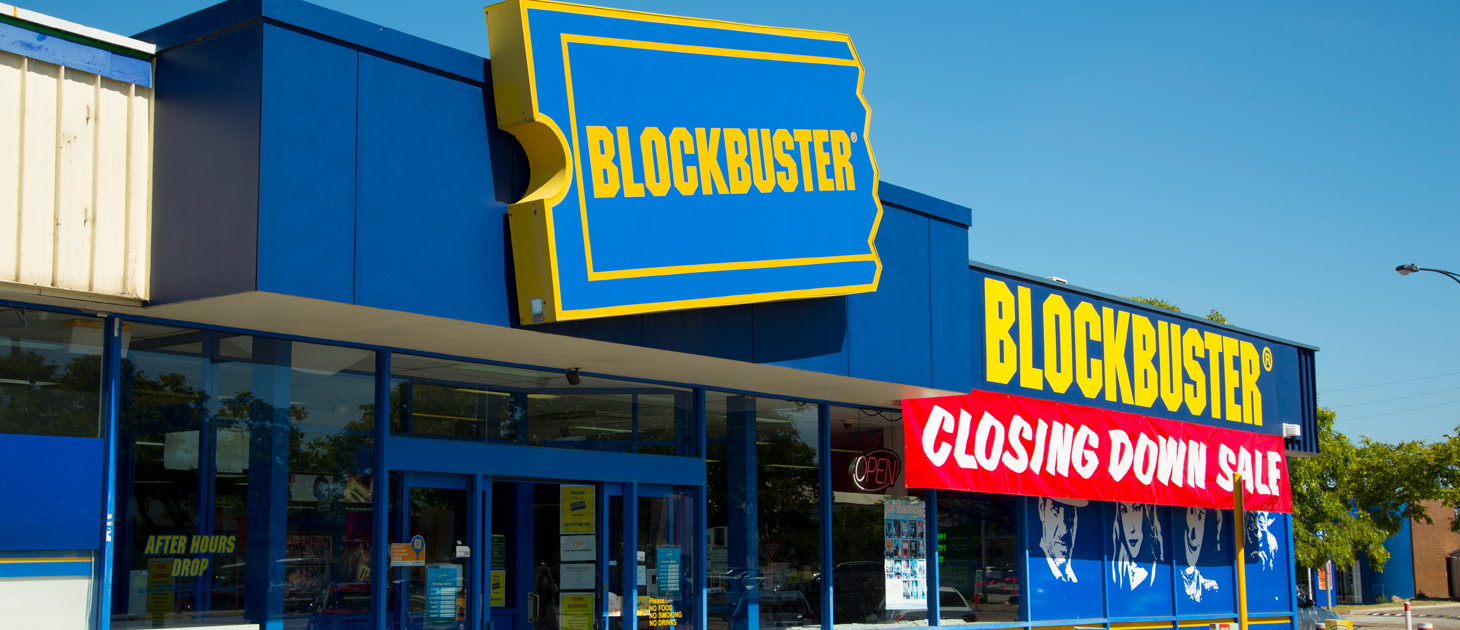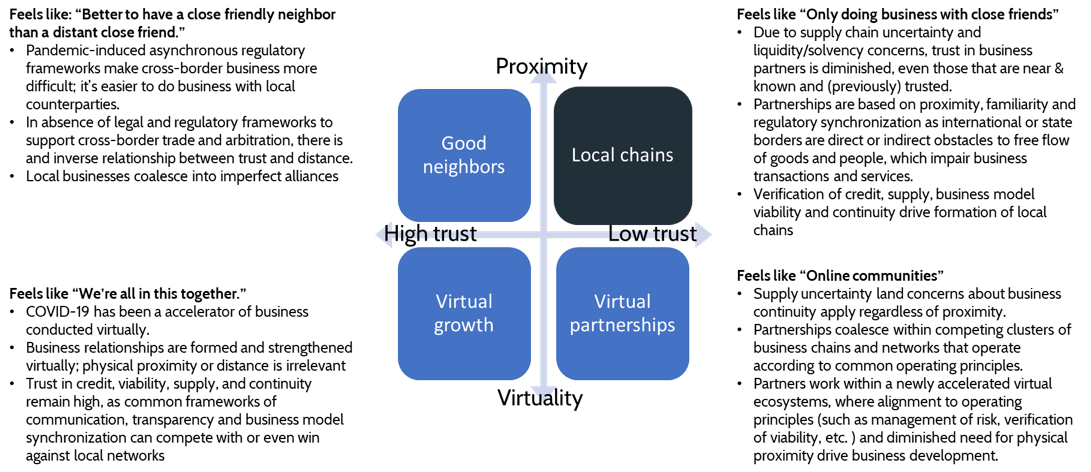Business Resiliency Through Scenario Planning
Today's uncertainties call for scenario planning, which provides insight to ensure business strategy, structure and capabilities remain resilient.

Uncertainty surrounding the impact of the COVID-19 pandemic and the shape of the economic recovery has made it impossible for small and middle-market business leaders to predict whether, when and how business will return to “normal.”
Still, leaders are tasked with steering their businesses forward beyond the immediate crisis. Predicting the severity of impact can help support public policy measures, but it doesn’t help assess and prepare a company’s fitness for a fundamentally different new normal. The uncertainties shaping the new future call for “scenario planning,” which provides critical insight to business owners and leaders to ensure business strategy, operating structure and organizational capabilities are resilient post-COVID-19.
Pioneered by Royal Dutch Shell amid volatile global oil markets in the 1970s, scenario planning is not about forecasting or envisioning the future. It’s a process to prepare a leadership team and key stakeholders around the idea that planning for “normal” isn’t good enough.
Kodak and Blockbuster present two cautionary examples. Kodak invented the digital camera and Blockbuster’s “Total Access” outgrew Netflix initially. These incumbents were well positioned to compete and even saw the change coming; in some cases, they were driving it. So what went wrong? Kodak simply couldn’t accept the inevitable decline of its profitable film business and pivot to new ways for consumers to experience pictures. Meanwhile, Blockbuster’s investors and franchisees couldn’t get on board with a different value proposition.
These examples speak to a critical lack of stakeholder alignment. One of the most important reasons for scenario planning is to rally leadership teams and stakeholders around the fact that the strategic vision, operating model and capabilities must be aligned to compete in any plausible future.
Prediction vs. Exploration
There are two types of scenarios used when looking toward the future: predictive (as in: good, not-so-good, bad) and explorative (think: post-apocalyptic, brave new world).
In the former type, we extrapolate trends, predict the severity of the impact of events, and plan for a future that is a slightly changed version of the present. This is helpful for annual planning and budgeting and easy to accept for most stakeholders. In the current crisis, consideration of different levels of the economic impact of the pandemic can be helpful in determining the impact on a business and stress test its capability to withstand or recover.

Scenario planning, on the other hand, involves the definition of alternate futures based on a few dimensions of fundamental uncertainty, thus exploring very different situations and assuming the future is not what it used to be. This shouldn’t be used for planning and budgeting. Typically, the uncertainties are related to long-term changes, such as geopolitical or economic shifts, deregulation or new technologies. Yet, due to COVID-19, some of these uncertainties are near-term.
Testing business resiliency and risk with scenarios is no longer a theoretical exercise for many large enterprises. It has become a priority for chief strategy officers, heads of risk management and chief legal officers.
One chief innovation officer at a major global risk insurance company describes working with his clients on scenario planning to help enterprises consider the long-term effects of their short-term decisions during this crisis. This CIO usually looks at longer term issues for the client companies, such as third-party threats, talent poaching and determining the yield from intellectual property assets. His team typically explores up to four or five distinct scenario narratives, expanding upon the basic variations to get at combinations of specific uncertainties and severity of threats. Each scenario planning exercise is customized to the specific industry and enterprise.
Using Relevant Uncertainties to Define Scenarios
COVID-19 can be a cause of discontinuity and a catalyst for accelerated trends, both of which can be a basis for defining scenarios. For leaders to engage in a meaningful and actionable strategic review of their business in a range of scenarios, the variables and trends subjected to discontinuity must be relevant to their business. A fundamentally different state on each variable should shake the business model to its core, challenging whether the business is resilient.
COVID-19 can be a cause of discontinuity and a catalyst for accelerated trends, both of which can be a basis for defining scenarios.
A software development company, for example, could consider trend acceleration and disruptions related to virtual engagement with customers and off-site service models: Is our operating model built to support custom software implementation through in-person development testing, training and service, or do our teams seamlessly collaborate virtually with customers? The uncertain variable here is the how virtual the collaboration can be.
Another potential disruptor is uncertainty around trust in business partners: Will we live in a world where we assume that our business partners are trustworthy (in the presumption of service levels and enforcement of trade rules) or will we require explicit guarantees (verification of performance, and escrows or blockchain technology to facilitate trade in capital assets and intellectual property)?
Trust in business partners presents an uncertainty variable for many industries. For a Tier 1 or Tier 2 supplier to an automotive or branded durable goods manufacturer, there are clear expectations under normal business conditions. Today, even the most sophisticated manufacturers are scrambling to understand risks associated with their fine-tuned supply chains, as we shift from performance measurement to unverifiable abilities to resume business. Going forward, will we see a shift in supplier bases as risk management takes on a larger role in supply chain management?
Plotting these variables and defining the resulting combinations yields four scenarios of futures dubbed Good Neighbors, Virtual Partnerships, Local Chains and Virtual Growth. Testing the ability of a software development business model to survive or thrive in each helps us to identify opportunities in ensuring strong local partnerships, robust yet inoffensive ways to verify capabilities, and a structural capability to work with our clients in both physical and virtual software development business scenarios.

Innovation itself can be disrupted in a crisis like COVID-19; will our business model be a catalyst for accelerated innovation, or will it be a casualty of disrupted budgets? The value proposition can result in both goodwill and strife with customers. Consider telemedicine. While health care providers are scrambling to roll out new ways to connect with patients, system crashes and a general lack of preparedness are undermining their efforts. Health systems will need to rapidly pick winning solutions for telemedicine delivery platforms. The forced increase of telemedicine due to COVID-19 will result in an accelerated shake-out of winners and losers.
These examples illustrate how scenario planning challenges the very ability of an enterprise to survive or compete. If done well, the exercise makes everyone just a bit uneasy. But there are clear benefits. Scenario planning has the power to inform leaders in making and convincing stakeholders of fundamentally different strategic choices in market positioning, innovation, value propositions, technology deployment, required capabilities and talent, as well as partnerships that a company must bring to bear in order to compete successfully in a post-pandemic new normal.
10 Steps For A Midmarket Company to Develop Scenarios for Resiliency Planning
- Set a time frame for exploring future scenarios. Typically, companies use strategic planning horizons or time frames driven by economic and innovation cycles. Given the pandemic-induced socioeconomic pivot we’re in, reduce the time frame from five years to 12-24 months.
- State or update the (implied) vision statement for your company in the given time frame.
- Brainstorm a list of major expectations, hopes and fears built into your company’s defined or implied vision. This represents the assumptions about how your company interacts with forces that shape its future position.
- Redefine the list of hopes and fears in terms of variables. Consolidate those that are redundant or correlated. The result should be a relatively small list of mostly unrelated variables. Don’t spend too much time on making your list mutually exclusive and collectively exhaustive, since scenario planning is not intended to be a deterministic exercise.
- Score the variables based on a combination of two factors:
- How specific is the impact (specificity)? The more succinctly your team can define the impact of alternate manifestations of the uncertain variable the better (Example: Proximity vs. Virtual).
- How large is the potential impact (quantity)? The most significant variables impact your business in orders of magnitude, rather than percentages (Example: High Trust vs. Low Trust).
- Identify the two variables with the highest combined scores.
- Define the four combinations based on the plausible opposite two future manifestations of each of the two variables. These are your theoretical scenarios.
- Have your team define reasonable storylines for how these four versions of the future could plausibly emerge from the present. This step is not only an engaging team-building exercise but also quite illuminating; it brings the scenarios to life. Be sure to name the scenarios for ease of reference.
- For each of the scenarios, assess the ability of your business operating model to profitably deliver the value proposition.
- Identify the options, investments and partners needed to ensure the robustness of your operating model and resiliency of your business for each scenario.


Marcel van der Elst (top photo) is a senior director with DWH Corporation based in Grand Rapids, Michigan. Mark Johnson (bottom photo) is a co-founder and managing partner at Michigan Software Labs based in Ada, Michigan.
Ben Borisch, partner and COO at DWH Corporation, and Greg Reese, a copywriter based in Grand Rapids, contributed to the article.


